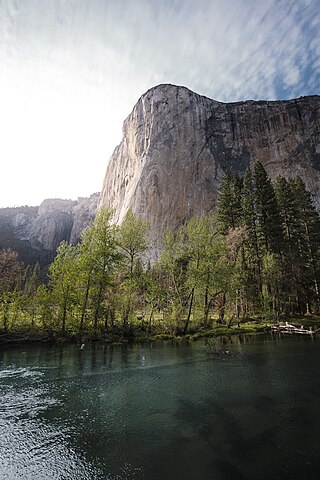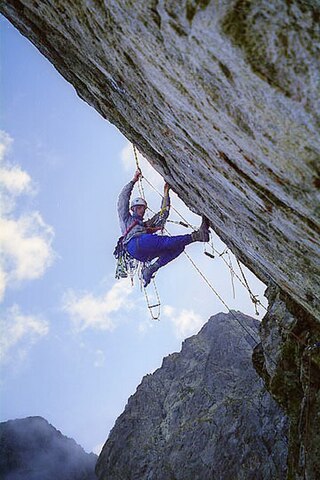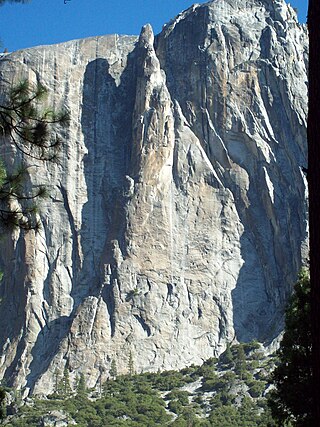
El Capitan is a vertical rock formation in Yosemite National Park, on the north side of Yosemite Valley, near its western end. The granite monolith is about 3,000 feet (914 m) from base to summit along its tallest face and is a world-famous location for big wall climbing, including the disciplines of aid climbing, free climbing, and more recently for free solo climbing.

Aid climbing is a form of rock climbing that uses mechanical devices and equipment, such as aiders, for upward momentum. Aid climbing is the opposite of free climbing, which only uses mechanical equipment for protection, but not to assist in upward momentum. "Traditional aid climbing" involves hammering in permanently fixed pitons and bolts, into which aiders are clipped, whereas "clean aid climbing" avoids hammering, and only uses removable placements.

Grand Teton is the highest mountain in Grand Teton National Park, in Northwest Wyoming, and a classic destination in American mountaineering.
Steve Roper is a noted climber and historian of the Sierra Nevada in the United States. He along with Allen Steck are the founding editors of the Sierra Club journal Ascent.

Royal Robbins was one of the pioneers of American rock climbing. After learning to climb at Tahquitz Rock, he went on to make first ascents of many big wall routes in Yosemite. As an early proponent of boltless, pitonless clean climbing, he, along with Yvon Chouinard, was instrumental in changing the climbing culture of the late 1960s and early 1970s by encouraging the use and preservation of the natural features of the rock. He went on to become a well-known kayaker.

Jim Bridwell was an American rock climber and mountaineer, active from 1965 in Yosemite Valley, but later in Patagonia and Alaska. He was noted for pushing the standards of both aid climbing and big wall climbing, and later alpine climbing. He wrote numerous articles on climbing and developed several important pieces of aid climbing equipment. Bridwell was an apprentice to Royal Robbins and Warren Harding, and later the unofficial leader of the Stonemasters.

The Regular Northwest Face of Half Dome was the first Grade VI big wall climbing route in the United States. It was first climbed in 1957 by a team consisting of Royal Robbins, Mike Sherrick, and Jerry Gallwas. Its current aid climbing rating is VI 5.9 A1 or 5.12 for the free climbing variation. It is recognized in the historic climbing text Fifty Classic Climbs of North America and considered a classic around the world.

In the history of rock climbing, the three main sub-disciplines—bouldering, single-pitch climbing, and big wall climbing—can trace their origins to late 19th-century Europe. Bouldering started in Fontainebleau, and was advanced by Pierre Allain in the 1930s, and John Gill in the 1950s. Big wall climbing started in the Dolomites, and was spread across the Alps in the 1930s by climbers such as Emilio Comici and Riccardo Cassin, and in the 1950s by Walter Bonatti, before reaching Yosemite where it was led in the 1950s to 1970s by climbers such as Royal Robbins. Single-pitch climbing started pre-1900 in both the Lake District and in Saxony, and by the late-1970s had spread widely with climbers such as Ron Fawcett (Britain), Bernd Arnold (Germany), Patrick Berhault (France), Ron Kauk and John Bachar (USA).

Layton Kor was an American rock climber active in the 1960s, whose first ascents and drive for climbing are well known in the climbing world. His routes included many climbs in Eldorado Canyon, near Boulder, Colorado, The Diamond on Longs Peak, towers in the desert southwest, and Yosemite National Park, among other locations. Notable among his first ascents is the Kor-Ingalls Route on Castleton Tower and The Finger of Fate Route up the Fisher Towers' Titan; both routes are recognized in the historic climbing text Fifty Classic Climbs of North America.

Big wall climbing is a form of rock climbing that takes place on long multi-pitch routes that normally require a full day, if not several days, to ascend. Big wall routes are typically sustained and exposed, where the climbers remain suspended from the rock face, even sleeping hanging from the face, with limited options to sit down or escape unless they abseil back down the whole route. It is therefore a physically and mentally demanding form of climbing.

The Nose is a big wall climbing route up El Capitan. Once considered impossible to climb, El Capitan is now the standard for big-wall climbing. It is recognized in the historic climbing text Fifty Classic Climbs of North America and considered a classic around the world.

Lotus Flower Tower is a peak in the Cirque of the Unclimbables, Northwest Territories, Canada. The tower is on a ridge one kilometre to the southwest of Mount Sir James MacBrien, and though the tower is not prominent in relation to surrounding peaks, it is noted for its sheer rock walls which are home to classic multi-pitch climbing routes.

The Salathé Wall is one of the original big wall climbing routes up El Capitan, a 3,000-foot (900 m) high granite monolith in Yosemite National Park. The Salathé Wall was named by Yvon Chouinard in honor of John Salathé, a pioneer of rock climbing in Yosemite. The route is recognized in the historic climbing text Fifty Classic Climbs of North America and is considered a classic around the world.

Lost Arrow Spire is a detached pillar in Yosemite National Park, in Yosemite Valley, California, located immediately adjacent to Upper Yosemite Falls. The structure includes the Lost Arrow Spire Chimney route which is recognized in the historic climbing text Fifty Classic Climbs of North America. The spire is the location for a dramatic Tyrolean traverse, which has since become an iconic slackline.

The Steck-Salathé Route is a big wall traditional climbing route up Sentinel Rock.

The Royal Arches is a cliff containing natural occurring granite exfoliation arches, located below North Dome and rising above Yosemite Valley, in Yosemite National Park, California.. These are not literal arches, but rather arch shaped indentations in the cliff face.
Allen Parker Steck was an American mountaineer and rock climber.

Peter Croft is a Canadian rock climber and mountaineer. He has concentrated much of his rock climbing career on big routes in Yosemite National Park, Squamish, British Columbia as well as the High Sierra. He received The American Alpine Club’s Robert & Miriam Underhill Award in 1991.

Thomas "Tom" M. Frost was an American rock climber known for big wall climbing first ascents in Yosemite Valley. He was also a photographer and climbing equipment manufacturer. Frost was born in Hollywood, California, and died in Oakdale, California.

Charles Marshall Pratt was an American rock climber known for big wall climbing first ascents in Yosemite Valley. He was also a long-time climbing instructor and mountain guide with Exum Mountain Guides in the Grand Tetons.


















